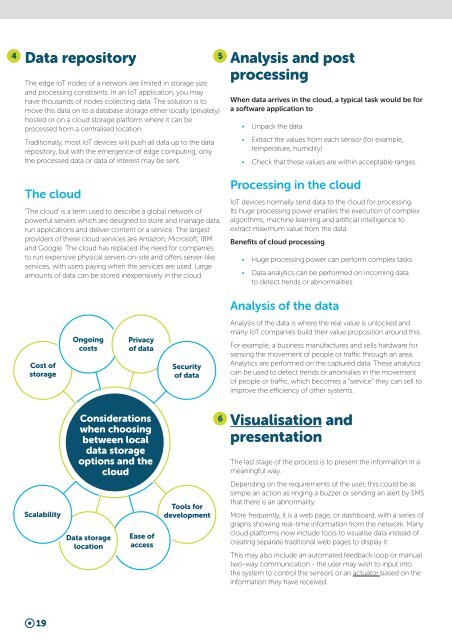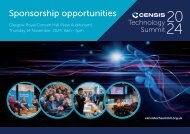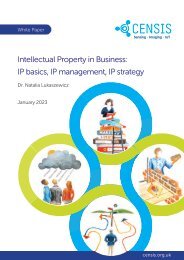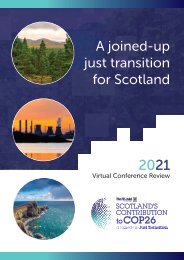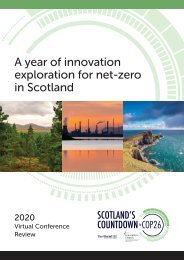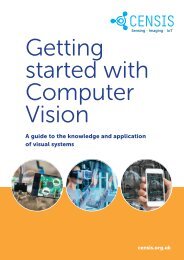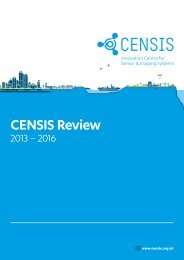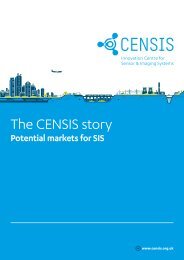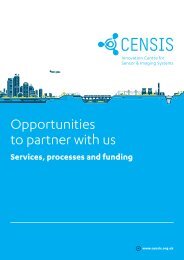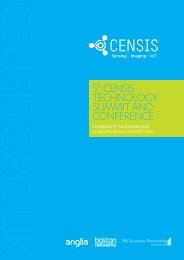Getting started with IoT
IoT is here and it's time for organisations across the country to take advantage of the transformational benefits of the technologies and expertise available. CENSIS explores IoT for business growth in this IoT starter guide. censis.org.uk
IoT is here and it's time for organisations across the country to take advantage of the transformational benefits of the technologies and expertise available. CENSIS explores IoT for business growth in this IoT starter guide. censis.org.uk
Create successful ePaper yourself
Turn your PDF publications into a flip-book with our unique Google optimized e-Paper software.
Data repository<br />
4 5<br />
The edge <strong>IoT</strong> nodes of a network are limited in storage size<br />
and processing constraints. In an <strong>IoT</strong> application, you may<br />
have thousands of nodes collecting data. The solution is to<br />
move this data on to a database storage either locally (privately)<br />
hosted or on a cloud storage platform where it can be<br />
processed from a centralised location.<br />
Traditionally, most <strong>IoT</strong> devices will push all data up to the data<br />
repository, but <strong>with</strong> the emergence of edge computing, only<br />
the processed data or data of interest may be sent.<br />
The cloud<br />
‘The cloud’ is a term used to describe a global network of<br />
powerful servers which are designed to store and manage data,<br />
run applications and deliver content or a service. The largest<br />
providers of these cloud services are Amazon, Microsoft, IBM<br />
and Google. The cloud has replaced the need for companies<br />
to run expensive physical servers on-site and offers server-like<br />
services, <strong>with</strong> users paying when the services are used. Large<br />
amounts of data can be stored inexpensively in the cloud.<br />
Analysis and post<br />
processing<br />
When data arrives in the cloud, a typical task would be for<br />
a software application to<br />
• Unpack the data<br />
• Extract the values from each sensor (for example,<br />
temperature, humidity)<br />
• Check that these values are <strong>with</strong>in acceptable ranges.<br />
Processing in the cloud<br />
<strong>IoT</strong> devices normally send data to the cloud for processing.<br />
Its huge processing power enables the execution of complex<br />
algorithms, machine learning and artificial intelligence to<br />
extract maximum value from the data.<br />
Benefits of cloud processing<br />
• Huge processing power can perform complex tasks<br />
• Data analytics can be performed on incoming data<br />
to detect trends or abnormalities<br />
Analysis of the data<br />
Cost of<br />
storage<br />
Ongoing<br />
costs<br />
Privacy<br />
of data<br />
Security<br />
of data<br />
Analysis of the data is where the real value is unlocked and<br />
many <strong>IoT</strong> companies build their value proposition around this.<br />
For example, a business manufactures and sells hardware for<br />
sensing the movement of people or traffic through an area.<br />
Analytics are performed on the captured data. These analytics<br />
can be used to detect trends or anomalies in the movement<br />
of people or traffic, which becomes a “service” they can sell to<br />
improve the efficiency of other systems.<br />
Scalability<br />
Considerations<br />
when choosing<br />
between local<br />
data storage<br />
options and the<br />
cloud<br />
Data storage<br />
location<br />
Ease of<br />
access<br />
Tools for<br />
development<br />
6<br />
Visualisation and<br />
presentation<br />
The last stage of the process is to present the information in a<br />
meaningful way.<br />
Depending on the requirements of the user, this could be as<br />
simple an action as ringing a buzzer or sending an alert by SMS<br />
that there is an abnormality.<br />
More frequently, it is a web page, or dashboard, <strong>with</strong> a series of<br />
graphs showing real-time information from the network. Many<br />
cloud platforms now include tools to visualise data instead of<br />
creating separate traditional web pages to display it.<br />
This may also include an automated feedback loop or manual<br />
two-way communication - the user may wish to input into<br />
the system to control the sensors or an actuator based on the<br />
information they have received.<br />
19


